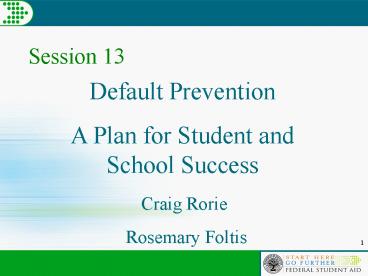Default Prevention - PowerPoint PPT Presentation
1 / 26
Title:
Default Prevention
Description:
Session 13 Default Prevention A Plan for Student and School Success Craig Rorie Rosemary Foltis Default Prevention & Management Plan Sections Default Prevention ... – PowerPoint PPT presentation
Number of Views:198
Avg rating:3.0/5.0
Title: Default Prevention
1
Session 13
Default Prevention A Plan for Student and
School Success
Craig Rorie Rosemary Foltis
2
Default Prevention Management PlanSections
Section I Sample Plan Overview Section II
Early Stages of Enrollment Section III Late
Stages of Enrollment Section IV After Students
Leave School Section V Enhanced Entrance/Exit
Counseling Section VI Tools and Activities for
Schools
3
Default Prevention Management Plan Which
schools must have a plan?
- Schools new to FFEL or DL
- Schools already in FFEL or DL following a change
in ownership resulting in a changein control
4
Default Prevention Management PlanWhich
schools should adopt default prevention
activities?
- All Schools
5
Default Prevention Management Plan What is
required by regulation for all schools?
- Providing Satisfactory Academic Progress
information across campus - Entrance and exit counseling for borrowers
- Timely and accurate enrollment reporting to NSLDS
6
Default Prevention Management Plan Focus on
Cohort Default Rates
- All-Time High?
1990 CDR 22.4
- All-Time Low?
2003 CDR 4.5
Thank you for your extra efforts to reduce
defaults!
7
Default Prevention Management Plan Beyond the
CDR - Dollars in Default
- Your CDR is low but are your dollars high?
- What is your loan volume?
- What is your CDR?
- Can you calculate the approximate dollars in
default at your school? - 1,000,000.00
(volume in dollars) x
4.5 (school CDR)
____________
45,000.00 (approx dollars in default)
8
Default Prevention Management PlanSection I
Overview
- Benefits of adopting a plan
- Reduces borrower defaults
- Promotes school success
- Consequences of default for borrowers
- Include adverse impact to credit record
- Consequences of default for schools
- Loss of Title IV eligibility
- May result in provisional certification
9
Default Prevention Management PlanSection II
Early Stages of Enrollment
- Entrance Counseling
- Financial Literacy for Borrowers
- Early Identification of At-Risk Borrowers
- Communication Across Campus
- Default Prevention and Retention Staff
10
Default Prevention Management Plan Entrance
Counseling
- Emphasize the important of paying loans
- Describe consequences of default
- Repayment options and payment amounts
- Obtain contact information
11
Default Prevention Management PlanFinancial
Literacy
- Include as part of entrance counseling
- Potential income of chosen occupation
- Interactive tools, including debt calculators,
e-tutorials - Loan servicer contact information
11
12
Default Prevention Management PlanStudents
At-Risk
- Causes and solutions of
- Unsatisfactory academic progress
- Withdrawals
- Inaccurate or late enrollment change reporting
- Analyze your data
12
13
Default Prevention Management Plan Resource
Leveraging
- Communication across campus
- School-wide effort, not just the responsibility
of financial aid office - Dedicated default prevention staff
- Establish working relationship with borrowers
- Include student retention efforts
14
Default Prevention Management PlanSection III
Late Stages of Enrollment
- Exit Counseling
- Withdrawals
- Timely and accurate enrollment reporting
15
Exit Counseling
- Last opportunity for borrowers to work
directly with school - Repayment plan options
- Forbearance and deferment options
15
16
Default Prevention Management PlanWithdrawals
- Withdraw Defaults
- Loss of part or all of grace period
- Use of LRDR to determine patterns
16
17
Default Prevention Management PlanWithdrawals
- Important questions about these borrowers
- Why are they at high risk for default?
- How early can you identify them?
- When did they withdraw?
17
18
Default Prevention Management PlanTimely
Accurate Reporting
- Ensure borrowers receive full grace period
- Ensure timely borrower contact by servicer
- Adhere to a monthly schedule
18
19
Default Prevention Management PlanSection IV
After Students Leave School
- NSLDS Date Entered Repayment (DER) Report
- Early Stage Delinquency Assistance (ESDA)
- Late Stage Delinquency Assistance (LSDA)
- Maintain Contact with Former Students
- Review Loan Record Detail Report (LRDR)
- Analyze Defaulted Loan Data to Identify Defaulter
Characteristics
20
Default Prevention Management Plan NSLDS
Reports
- Particular emphasis on the following
- Date Entered Repayment Report (DER)
- Loan Record Detail Report (LRDR)
- Late Stage Delinquency Assistance (LSDA)
21
Default Prevention Management Plan Late Stage
Delinquency Assistance (LSDA)
- Available to all schools
- Simple process
- Immediate impact
- Yields dramatic results
22
Default Prevention Management PlanSection V
Enhanced
Entrance and Exit Counseling
- Requests for borrower information
- Information about repaying the loan
- Reminders about personal financial management and
Title IV loans
23
Default Prevention Management PlanSection VI
Tools
and Activities for Schools
- FSA Assessments for default prevention and
management - Loan counseling
- Enrollment reporting and data accuracy
- Default prevention
- General connections/publications
24
Default Prevention Management PlanTools for
Schools
- NSLDS For Students
- IFAP
- http//www.studentaid.ed.gov
25
Default Prevention Management PlanSummary
- The new sample plan includes activities that
- promote student, school, and loan program
success - are inter-related with existing requirements
and systems - are easy to implement and do not require much
in the way of resources
26
Default Prevention Management Plan
- We appreciate your feedback and comments.
- We can be reached at
Phone (202) 377-4259 Email
fsa.schools.default.management_at_ed.gov
craig.rorie_at_ed.gov
rosemary.foltis_at_ed.gov































